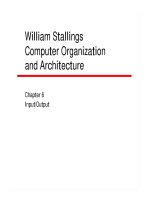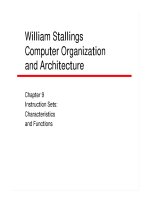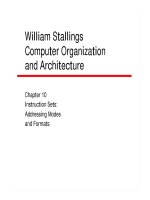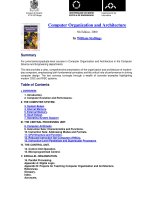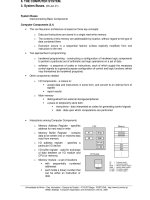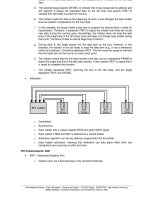Bài giảng Computer Organization and Architecture: Chapter 13
Bạn đang xem bản rút gọn của tài liệu. Xem và tải ngay bản đầy đủ của tài liệu tại đây (321.39 KB, 38 trang )
William Stallings
Computer Organization
and Architecture
6th Edition
Chapter 13
Reduced Instruction
Set Computers
Major Advances in Computers(1)
• The family concept
—IBM System/360 1964
—DEC PDP8
—Separates architecture from implementation
• Microporgrammed control unit
—Idea by Wilkes 1951
—Produced by IBM S/360 1964
• Cache memory
—IBM S/360 model 85 1969
Major Advances in Computers(2)
• Solid State RAM
—(See memory notes)
• Microprocessors
—Intel 4004 1971
• Pipelining
—Introduces parallelism into fetch execute cycle
• Multiple processors
The Next Step - RISC
• Reduced Instruction Set Computer
• Key features
—Large number of general purpose registers
—or use of compiler technology to optimize register use
—Limited and simple instruction set
—Emphasis on optimising the instruction pipeline
Comparison of processors
Driving force for CISC
•
•
•
•
Software costs far exceed hardware costs
Increasingly complex high level languages
Semantic gap
Leads to:
—Large instruction sets
—More addressing modes
—Hardware implementations of HLL statements
– e.g. CASE (switch) on VAX
Intention of CISC
• Ease compiler writing
• Improve execution efficiency
—Complex operations in microcode
• Support more complex HLLs
Execution Characteristics
•
•
•
•
Operations performed
Operands used
Execution sequencing
Studies have been done based on programs
written in HLLs
• Dynamic studies are measured during the
execution of the program
Operations
• Assignments
—Movement of data
• Conditional statements (IF, LOOP)
—Sequence control
• Procedure callreturn is very time consuming
• Some HLL instruction lead to many machine
code operations
Relative Dynamic Frequency
Assign
Loop
Call
If
GoTo
Other
Dynamic
Occurrence
Pascal C
45
38
5
3
15
12
29
43
3
6
1
Machine Instruction
(Weighted)
Pascal C
13
13
42
32
31
33
11
21
3
1
Memory Reference
(Weighted)
Pascal C
14
15
33
26
44
45
7
13
2
1
Operands
• Mainly local scalar variables
• Optimisation should concentrate on accessing
local variables
Integer constant
Scalar variable
Array/structure
Pascal
16
58
26
C
23
53
24
Average
20
55
25
Procedure Calls
•
•
•
•
Very time consuming
Depends on number of parameters passed
Depends on level of nesting
Most programs do not do a lot of calls followed
by lots of returns
• Most variables are local
• (c.f. locality of reference)
Implications
• Best support is given by optimising most used
and most time consuming features
• Large number of registers
—Operand referencing
• Careful design of pipelines
—Branch prediction etc.
• Simplified (reduced) instruction set
Large Register File
• Software solution
—Require compiler to allocate registers
—Allocate based on most used variables in a given
time
—Requires sophisticated program analysis
• Hardware solution
—Have more registers
—Thus more variables will be in registers
Registers for Local Variables
•
•
•
•
•
•
Store local scalar variables in registers
Reduces memory access
Every procedure (function) call changes locality
Parameters must be passed
Results must be returned
Variables from calling programs must be
restored
Register Windows
•
•
•
•
•
Only few parameters
Limited range of depth of call
Use multiple small sets of registers
Calls switch to a different set of registers
Returns switch back to a previously used set of
registers
Register Windows cont.
• Three areas within a register set
—Parameter registers
—Local registers
—Temporary registers
—Temporary registers from one set overlap parameter
registers from the next
—This allows parameter passing without moving data
Overlapping Register Windows
Circular Buffer diagram
Operation of Circular Buffer
• When a call is made, a current window pointer is
moved to show the currently active register
window
• If all windows are in use, an interrupt is
generated and the oldest window (the one
furthest back in the call nesting) is saved to
memory
• A saved window pointer indicates where the
next saved windows should restore to
Global Variables
• Allocated by the compiler to memory
—Inefficient for frequently accessed variables
• Have a set of registers for global variables
Registers v Cache
• Large Register File
Cache
•
•
•
Recently used local scalars
Blocks of memory
Recently used global
•
•
All local scalars
Individual variables
Compiler assigned global variables
variables
Save/restore based on procedure
nesting
Register addressing
Save/restore based on
caching algorithm
Memory addressing
Referencing a Scalar Window Based Register File
Referencing a Scalar - Cache
Compiler Based Register Optimization
• Assume small number of registers (1632)
• Optimizing use is up to compiler
• HLL programs have no explicit references to
registers
—usually think about C register int
• Assign symbolic or virtual register to each
candidate variable
• Map (unlimited) symbolic registers to real
registers
• Symbolic registers that do not overlap can share
real registers
• If you run out of real registers some variables
use memory

